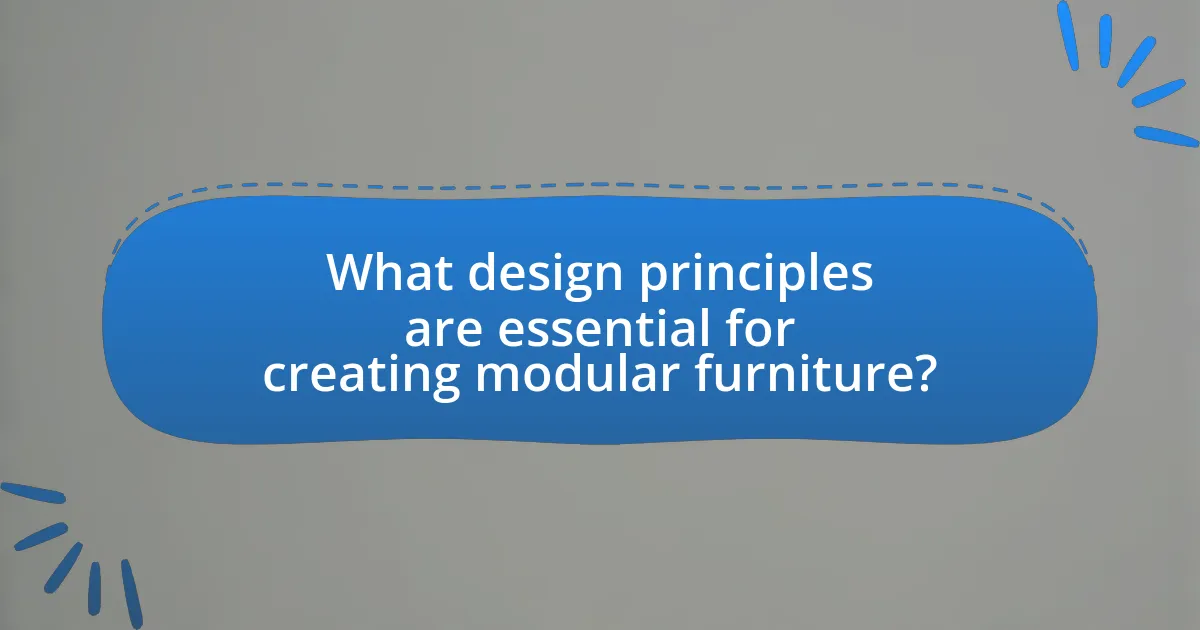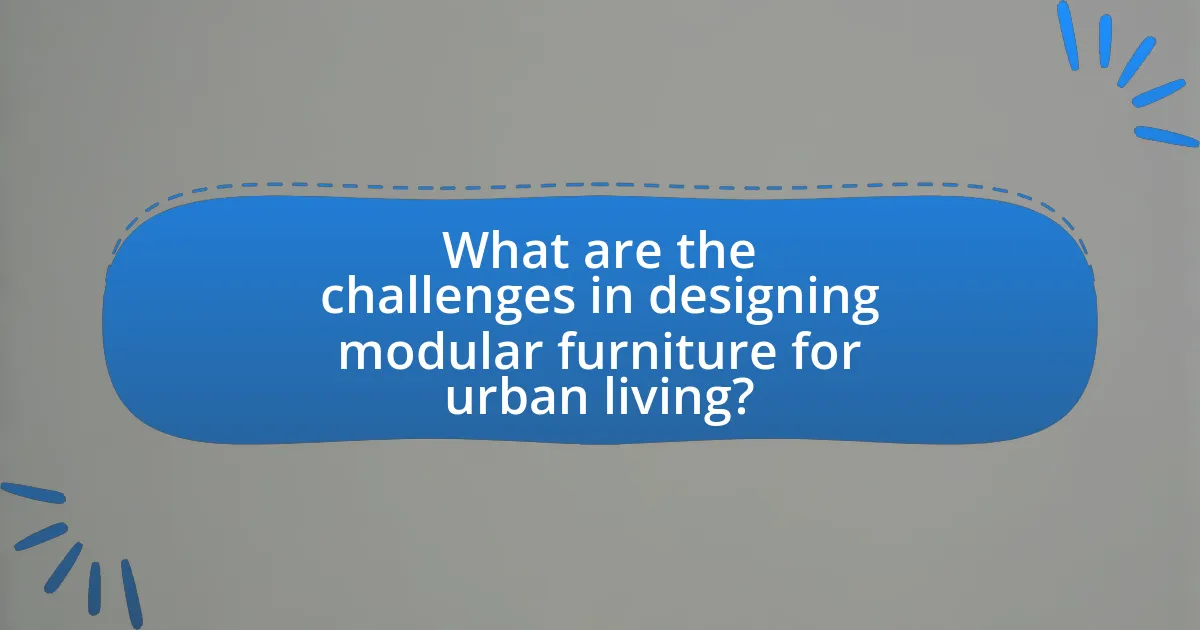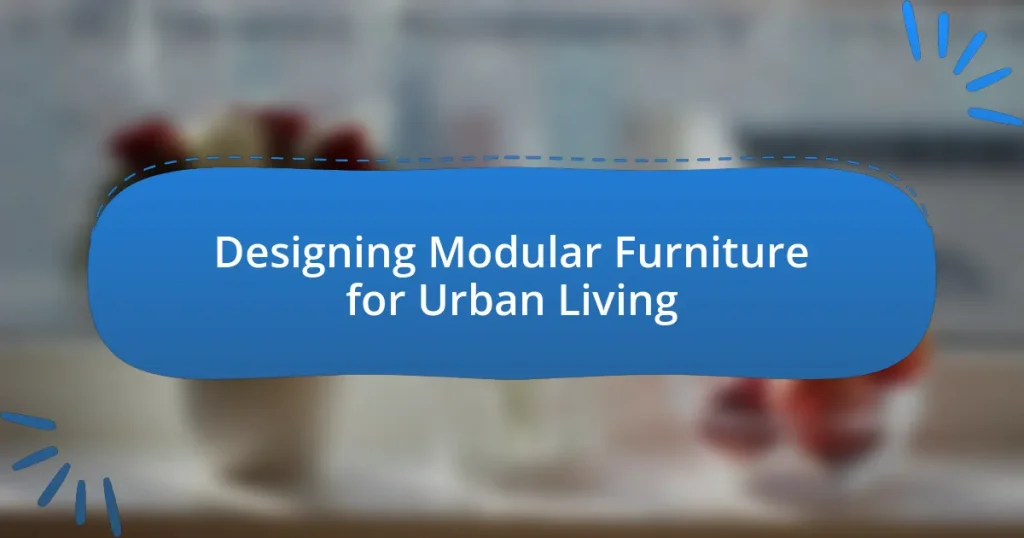Modular furniture for urban living is designed to maximize space efficiency and adaptability in limited living environments. This article explores the characteristics that differentiate modular furniture from traditional options, emphasizing its flexibility, multifunctionality, and aesthetic appeal. Key benefits include enhanced usability in small apartments, cost advantages, and the integration of user-centered design principles. The discussion also addresses the challenges of creating durable, visually appealing modular pieces that meet the demands of urban dwellers, while highlighting market trends and technological advancements shaping the future of modular furniture.

What is Modular Furniture for Urban Living?
Modular furniture for urban living refers to versatile, space-efficient furniture systems designed to adapt to the limited space and dynamic needs of urban environments. This type of furniture typically consists of individual components that can be rearranged or combined in various configurations, allowing for customization based on the user’s preferences and spatial constraints. For instance, modular sofas can be reconfigured into different shapes, while modular shelving units can be expanded or reduced in size. The design of modular furniture often emphasizes functionality, ease of assembly, and aesthetic appeal, making it suitable for small apartments and multi-functional spaces.
How does modular furniture differ from traditional furniture?
Modular furniture differs from traditional furniture primarily in its flexibility and adaptability. While traditional furniture is typically fixed in design and function, modular furniture consists of individual pieces that can be rearranged or combined in various configurations to suit different spaces and needs. This adaptability allows modular furniture to maximize space efficiency, particularly in urban living environments where square footage is often limited. For example, a modular sofa can be reconfigured into different shapes or sizes, accommodating various room layouts and purposes, unlike a traditional sofa that remains static in its form.
What are the key characteristics of modular furniture?
Modular furniture is characterized by its flexibility, adaptability, and space efficiency. This type of furniture consists of individual units that can be rearranged or combined in various configurations to suit different needs and spaces. For instance, modular sofas can be reconfigured into different shapes, allowing for customization based on room layout or user preference. Additionally, modular furniture often features lightweight materials, making it easy to move and reassemble, which is particularly beneficial in urban living environments where space is limited. The design of modular furniture also emphasizes functionality, often incorporating storage solutions within the units, thus maximizing utility in compact living spaces.
Why is modularity important in urban living?
Modularity is important in urban living because it allows for flexible and efficient use of limited space. In densely populated areas, modular designs enable residents to adapt their living environments to changing needs, such as accommodating guests or creating multifunctional areas. Research indicates that modular furniture can maximize utility in small apartments, with studies showing that modular systems can increase usable space by up to 30% compared to traditional furniture arrangements. This adaptability not only enhances comfort but also promotes sustainable living by reducing the need for multiple pieces of furniture, thereby minimizing waste and resource consumption.
What are the primary benefits of modular furniture in urban settings?
The primary benefits of modular furniture in urban settings include space efficiency, versatility, and adaptability. Urban environments often feature limited living space, making modular furniture ideal as it can be reconfigured to fit various needs and layouts. For instance, a modular sofa can be rearranged to create different seating arrangements, maximizing the use of available space. Additionally, modular furniture often incorporates storage solutions, further enhancing functionality in compact areas. Studies show that modular designs can improve the usability of small apartments by up to 30%, demonstrating their effectiveness in urban living scenarios.
How does modular furniture maximize space efficiency?
Modular furniture maximizes space efficiency by allowing for flexible configurations that adapt to various needs and room sizes. This adaptability enables users to reconfigure their living spaces easily, accommodating different activities or guest numbers without requiring additional square footage. For instance, modular sofas can be rearranged into different shapes, and modular shelving can be expanded or contracted based on storage needs. Studies indicate that urban dwellers often face limited space, and modular designs effectively utilize vertical and horizontal areas, making the most of compact living environments.
What cost advantages does modular furniture offer?
Modular furniture offers significant cost advantages, primarily through its versatility and space efficiency. By allowing users to customize configurations based on their specific needs, modular furniture reduces the need for multiple separate pieces, leading to lower overall expenditure. Additionally, the ability to easily reconfigure or expand modular systems means that consumers can adapt their furniture as their living situations change, avoiding the costs associated with purchasing new items. Studies indicate that modular designs can lead to savings of up to 30% compared to traditional furniture solutions, as they minimize waste and maximize utility in urban living spaces.

What design principles are essential for creating modular furniture?
Essential design principles for creating modular furniture include flexibility, scalability, and functionality. Flexibility allows furniture pieces to adapt to various spaces and user needs, enabling configurations that can change over time. Scalability ensures that the furniture can be expanded or reduced in size, accommodating different living environments, particularly in urban settings where space is limited. Functionality emphasizes the importance of multi-use designs, where a single piece serves multiple purposes, enhancing efficiency and utility. These principles are validated by the growing trend in urban living, where adaptable and space-saving solutions are increasingly sought after to maximize limited square footage.
How can functionality be integrated into modular furniture design?
Functionality can be integrated into modular furniture design by incorporating adaptable components that serve multiple purposes. For instance, furniture pieces can be designed to transform from a seating area to a sleeping space, or include built-in storage solutions to maximize space efficiency. Research indicates that modular furniture can enhance urban living by providing flexibility and optimizing limited space, as seen in studies highlighting the increasing demand for multifunctional furniture in small apartments. This approach not only meets the practical needs of urban dwellers but also aligns with contemporary design trends that prioritize versatility and space-saving solutions.
What features enhance the adaptability of modular furniture?
Modular furniture enhances adaptability through features such as reconfigurability, scalability, and multifunctionality. Reconfigurability allows users to rearrange components to fit different spaces and needs, making it suitable for various room layouts. Scalability enables the addition or removal of pieces, accommodating changing requirements over time. Multifunctionality incorporates multiple uses into a single piece, such as a sofa that converts into a bed, maximizing utility in limited urban living spaces. These features collectively support the dynamic lifestyle often found in urban environments, where space is at a premium and flexibility is essential.
How does user-centered design influence modular furniture?
User-centered design significantly influences modular furniture by prioritizing the needs and preferences of users in the design process. This approach ensures that modular furniture is adaptable, functional, and aesthetically pleasing, catering to diverse living spaces and lifestyles. For instance, research indicates that user-centered design leads to increased satisfaction and usability, as it incorporates feedback from potential users during the development phase. By focusing on how individuals interact with their environment, designers can create modular pieces that maximize space efficiency and enhance user experience, ultimately resulting in furniture that is not only practical but also aligns with the evolving demands of urban living.
What aesthetic considerations should be made in modular furniture design?
Aesthetic considerations in modular furniture design include functionality, versatility, and visual harmony. Functionality ensures that each piece serves a purpose while being adaptable to various spaces, which is crucial in urban living environments where space is limited. Versatility allows furniture to be reconfigured or combined in different ways, catering to the dynamic needs of users. Visual harmony involves selecting colors, materials, and forms that create a cohesive look, enhancing the overall aesthetic appeal of the living space. For instance, research indicates that modular furniture can improve spatial efficiency and aesthetic satisfaction in small apartments, highlighting the importance of these aesthetic considerations in urban settings.
How can color and material choices impact urban living spaces?
Color and material choices significantly impact urban living spaces by influencing aesthetics, functionality, and psychological well-being. For instance, lighter colors can make small urban apartments appear larger and more open, while darker hues can create a cozy atmosphere. Materials such as wood or natural fibers can enhance warmth and comfort, making spaces feel more inviting. Research indicates that color can affect mood; for example, blue tones are often associated with calmness, which can be beneficial in high-density urban environments where stress levels may be elevated. Additionally, sustainable materials contribute to environmental well-being, aligning with the growing trend of eco-conscious living in urban areas.
What role does style play in the appeal of modular furniture?
Style significantly enhances the appeal of modular furniture by allowing it to seamlessly integrate into diverse living spaces. The aesthetic versatility of modular designs caters to various tastes, enabling consumers to personalize their environments. For instance, a study by the American Society of Interior Designers highlights that 75% of consumers prioritize style when selecting furniture, indicating that visual appeal is a crucial factor in purchasing decisions. This adaptability not only meets functional needs but also aligns with contemporary design trends, making modular furniture a popular choice for urban living.

What are the challenges in designing modular furniture for urban living?
The challenges in designing modular furniture for urban living include limited space, the need for multifunctionality, and aesthetic appeal. Urban environments often feature smaller living areas, which necessitate furniture that can be easily reconfigured or compactly stored. For instance, according to a study by the American Institute of Architects, 60% of urban dwellers live in apartments under 1,000 square feet, highlighting the demand for space-efficient solutions. Additionally, modular furniture must serve multiple purposes, such as a sofa that converts into a bed or storage unit, to maximize utility in constrained spaces. Lastly, designers face the challenge of creating visually appealing pieces that fit diverse interior styles while remaining functional, as urban residents often prioritize both form and function in their living spaces.
How do space limitations affect modular furniture design?
Space limitations significantly influence modular furniture design by necessitating versatility and compactness. Designers must create pieces that can adapt to various configurations and functions, allowing for efficient use of limited square footage. For instance, modular sofas can be rearranged to fit different room layouts, while foldable tables can be stored away when not in use. This adaptability is crucial in urban environments where living spaces are often smaller, with statistics indicating that urban dwellers typically have 30% less living space than their suburban counterparts. Consequently, the design process prioritizes multifunctionality and space-saving features, ensuring that each piece serves multiple purposes without compromising on aesthetics or comfort.
What strategies can be employed to overcome design constraints?
To overcome design constraints in modular furniture for urban living, designers can employ strategies such as iterative prototyping, user-centered design, and material optimization. Iterative prototyping allows designers to test and refine concepts quickly, ensuring that solutions are practical and meet user needs. User-centered design focuses on understanding the specific requirements and preferences of urban dwellers, which can lead to innovative solutions that maximize functionality in limited spaces. Material optimization involves selecting lightweight, durable materials that enhance the modularity and adaptability of furniture, making it easier to transport and reconfigure. These strategies are supported by case studies in design innovation, such as the work of IKEA, which emphasizes adaptability and user engagement in its product development process.
How can designers ensure durability in compact designs?
Designers can ensure durability in compact designs by selecting high-quality materials and employing robust construction techniques. For instance, using engineered wood or metal alloys can enhance strength while maintaining a lightweight profile. Additionally, incorporating features such as reinforced joints and modular components can improve longevity and adaptability. Research indicates that furniture made with durable materials can last significantly longer, reducing the need for replacements and minimizing waste, which is crucial in urban living contexts where space and resources are limited.
What market trends are influencing modular furniture design?
Market trends influencing modular furniture design include the rise of urbanization, increased demand for multifunctional spaces, and sustainability concerns. Urbanization drives the need for space-efficient solutions, as more people live in smaller apartments. This trend has led to a preference for modular furniture that can adapt to various functions, such as sofas that convert into beds or tables that expand for dining. Additionally, sustainability is becoming a priority, with consumers favoring eco-friendly materials and production methods, prompting designers to incorporate recycled materials and sustainable practices into their modular designs. According to a report by Grand View Research, the global modular furniture market is expected to grow significantly, reflecting these trends and consumer preferences.
How is sustainability shaping the future of modular furniture?
Sustainability is significantly shaping the future of modular furniture by driving the design and production processes towards eco-friendly materials and practices. Manufacturers are increasingly adopting sustainable materials such as recycled plastics, bamboo, and responsibly sourced wood, which reduces environmental impact. For instance, a report by the Ellen MacArthur Foundation highlights that the circular economy model, which emphasizes reusing and recycling materials, is becoming integral in furniture design, promoting longevity and adaptability in modular systems. This shift not only meets consumer demand for environmentally responsible products but also aligns with global sustainability goals, making modular furniture a key player in urban living solutions.
What technological advancements are impacting modular furniture?
Technological advancements impacting modular furniture include 3D printing, smart technology integration, and sustainable materials. 3D printing allows for customized designs and rapid prototyping, enabling manufacturers to create unique modular pieces tailored to specific consumer needs. Smart technology integration, such as IoT-enabled furniture, enhances functionality by allowing users to control lighting, temperature, and other features through mobile applications. Additionally, the use of sustainable materials, driven by advancements in recycling and material science, promotes eco-friendly production methods, appealing to environmentally conscious consumers. These advancements collectively enhance the versatility, functionality, and sustainability of modular furniture in urban living spaces.
What are some best practices for designing modular furniture?
Best practices for designing modular furniture include ensuring versatility, optimizing space efficiency, and prioritizing user customization. Versatility allows furniture pieces to serve multiple functions, such as a sofa that converts into a bed, which is essential in urban living where space is limited. Space efficiency is crucial; modular designs should maximize usable area while minimizing bulk, as seen in designs that can be easily rearranged or stacked. User customization enhances the appeal of modular furniture, allowing individuals to adapt pieces to their specific needs and preferences, which is supported by trends in consumer behavior that favor personalized solutions.
How can designers effectively gather user feedback during the design process?
Designers can effectively gather user feedback during the design process by employing methods such as user interviews, surveys, usability testing, and focus groups. User interviews allow designers to gain in-depth insights into user preferences and pain points, while surveys can reach a broader audience to collect quantitative data on user satisfaction. Usability testing enables designers to observe real-time interactions with prototypes, identifying areas for improvement. Focus groups facilitate discussions among users, providing diverse perspectives on design concepts. Research indicates that incorporating user feedback at multiple stages of the design process can lead to products that better meet user needs, ultimately enhancing user satisfaction and product success.
What tips can enhance the functionality of modular furniture in small spaces?
To enhance the functionality of modular furniture in small spaces, prioritize multi-purpose designs that serve more than one function, such as a sofa bed or an ottoman with storage. These designs maximize utility and minimize clutter, which is essential in limited areas. Additionally, consider modular pieces that can be easily rearranged or expanded, allowing for flexibility in layout and accommodating different activities or guest needs. Research indicates that adaptable furniture can significantly improve space efficiency, making it a practical choice for urban living environments.


